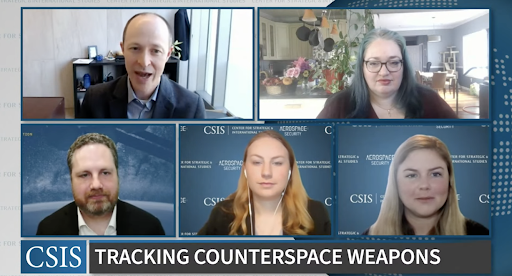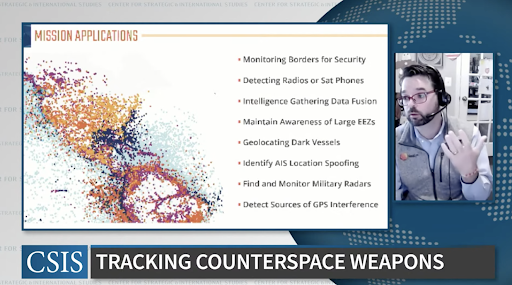CSIS - Tracking Developments in Counterspace Weapons
Panelists Todd Harrison, Victoria Samson, Michael Mineiro, Kaitlyn Johnson, and Makena Young (from top left to bottom right)
Key Points
Counterspace weapons create dangerous space debris that can negatively impact the space environment
The United States committed to not conduct destructive direct descent anti-satellite missile testing and seeks to establish its commitment as an international norm
Research into current space technologies will allow for future prevention of harmful counterspace weapons
Summary
On April 20, 2022, 9:00 am EDT, the Center for Strategic and International Studies’ Aerospace Security Project and the Secure World Foundation brought together a panel of experts to discuss tracking developments in counterspace weapons. The panel was moderated by Todd Harison, the Director for the Aerospace Security Project.
Harrison prompted the discussion by inviting two featured government speakers to discuss the United States’ recent commitment not to conduct destructive direct descent anti-satellite missile testing. John Hill, Deputy Assistant Secretary of Defense for Space and Missile Defense Policy introduced the policy behind the announcement. Hill stated that the U.S. seeks to establish this commitment as a new international norm for responsible behavior in space. As an international standard, this commitment must meaningfully limit the creation of orbital debris while also being easily understandable among the international community, consistent with existing U.S. policy, and preserving U.S. security.
Eric Desautels of the U.S. Department of State continued by discussing how the U.S. plans to carry out its commitment. Desautels stated that a UN open-ended working group will meet over the next two years to “make recommendations on possible norms, rules, and principles of responsible behavior related to threats by states including how they will contribute to legal binding instruments and the prevention of an arms race.” Desautels confirmed that the U.S. government believes this commitment provides an excellent first step in providing security and stability to the outer space environment despite diplomatic timelines for restricting such conflicts from entering outer space. He also affirmed that there is still more to be done beyond this commitment.
Next, Michael Mineiro, Vice President for Legal, Regulatory and Governmental Affairs at Hawkeye 360 discussed the logistics and applications of his commercial space company’s satellites. Mineiro explained that Hawkeye 360 launches clusters of satellites, collects signals, renders them, and fuses the data for delivery. He discussed that the satellites help monitor border security, detect radios or SAT phones, and even protect wildlife. Recently, Hawkeye 360’s satellites detected interference in the separast region of Ukraine which served as a warning of combined military operations.
Visual of Hawkeye 360 mission applications
At this point in the discussion, the rest of the panelists addressed the U.S. announcement regarding counterspace weapons and were asked about the effectiveness of such a policy. Victoria Samson, Washington Office Director for the Secure World Foundation, thought it was encouraging that the U.S. put together a feasible and workable solution. Based on research, she took the stance that many other countries will get on board because debris causes immense damage to the space environment which rationally all countries want access to.
Todd Harrison then addressed some of the concerns regarding the policy, such as the fear that it will limit U.S. military capabilities if testing were to continue. Harrison stated that because we know it works, the US would rarely use it in a conflict because of the proven excess debris, emphasizing that our capabilities and future for weapons testing lie elsewhere.
After discussing regulations in counterspace weaponry, the panel discussed current space technologies being used. Dr. Brian Weeden, Director of Program Planning at the Secure World Foundation, explained that Russia’s use of GPS and satellite jamming against Ukraine is not unexpected based on their previous campaign against Syria. He stated that the good news is that Russia is not destroying satellites, creating further debris, but instead deteriorating information to end users.
Kaitlyn Johnson, Deputy Director and Fellow at Aerospace Security Project, elaborated by stating that the attack on end-user equipment instead of satellites will allow a better re-design of equipment for better protection in the future. Regarding the future of space technologies, Victoria Samson discussed the Space Threat Assessment 2022 which details the addition of three more countries with civil space programs. The report looks into establishing space security programs to counter potential space threats.
To conclude the discussion, Makena Young and Kaitlyn Johnson reported on updates regarding counterspace weapons in Russia and China. Makena Young, Associate Fellow at the Aerospace Security Project, spoke on the Russian anti-satellite (ASAT) test in November 2021. This test hit one of Russia’s older satellites creating excessive debris and acted as a deliberate show of force. As a result of this test, astronauts in the ISS and China’s space station had to shelter in place due to the debris. By witnessing the real harm space debris has, Young predicted that China may adopt a similar policy to the US regarding counterspace weapons which could also put pressure on Russia to do the same.
Kaitlyn Johnson concluded by touching on the SJ21 satellite that was launched in October 2021 by the Chinese government to test technologies that mitigate space debris. After its launch, it docked with a previously inactive satellite. Research into the event is being conducted as well as other developments regarding counter space weapons tracked because such information could demonstrate the kind of technology needed to create counterspace future weapons and reveal where the demand is for such technology.


